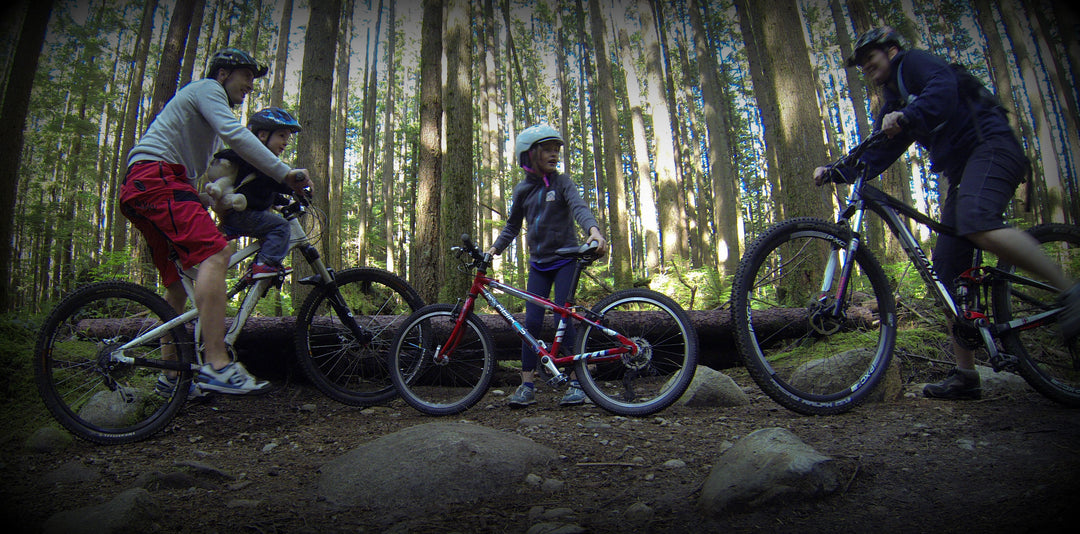Designed for Safety
On This Page
For more information on the Ride More system and getting on & off safely, visit our Important Safety Information page.
DISCUSSION ON SAFETY
When seeing the Ride More system for the first time, the first comment from many is something like, “That looks fun, but how safe is it?”
The answer: Safer than you think.
Our kids are my world, and so although we enjoy challenging ourselves when we ride alone, we would never put our children at risk. But that is not to say we won’t let them get hurt from time to time, in the normal course of pushing their boundaries and learning about their bodies. Because they do.
We take safety very seriously.
The Ride More system is designed with safety in mind, even though some of the ways we address it are not the same as more conventional child bike seats. We believe that the Ride More way is in some ways even more safe than conventional seats, and more fun too.
Safety is important, and all parents must take responsibility for the safety of their children. We believe that the Ride More system is among the safest - and most fun! - bike seats on the market today. We have broken down some of the chief areas of safety with regards to child bike seats, and our philosophy.
RIDE MORE SAFETY TOPICS & DESIGN
SAFETY CERTIFICATION
There is currently no safety certification for front-mounted child bike seats. The closest thing we have found is EN 14344 which is the safety standard for child bike seats in the EU, however it doesn’t cover front-mounted seats that carry children over 15kg. We have conformed to it as much as possible, with the exception of the safety strap, which we address below.
FORWARD-MOUNTED VS. REAR-MOUNTED
Conventional rear-mounted philosophy: Child is protected from front impact by the rider’s body.
The Ride More way: The forward positioning of the Ride More system allows parent and child to chat, while the child can see what’s going on and actively participate in the ride. With Mac Ride, holding the handlebars, standing on the foot pegs and leaning into corners develops strength, balance, coordination and love of biking. The child in the rear is a passive passenger, and can not see what is going on or interact with the rider. Children in the back often lean to the side to see what’s coming up which can dangerously affect the balance of the rider, and the rider can not see whether the child is engaged in the ride, sleeping, or in a more dangerous position so must take their eyes off the road to make sure s/he is okay.
FOR CHILDREN AGES 2-5 - MAC RIDE
NO MOULDED PLASTIC SEAT
Conventional philosophy: The child is most comfortable in a seat that is shaped to their body and allows their back and neck to rest, or even sleep.
The Ride More way: The positioning of Mac Ride is such that the child benefits from the suspension of the bike so they do not rattle around, but are able to absorb any shock from bumps just as the rider does. Plastic seats conduct the bumps of the road or trail.
FOOT STRAPS
Conventional philosophy: Feet are contained by plastic or steel cups or shields. Foot straps are not necessary because the child is strapped in with a 5-point harness or waist belt.
The Ride More way: With Mac Ride, soft, adjustable foot straps keep the foot snugly attached to the stirrup during a bumpy ride, while allowing it to disengage in a fall. The child’s foot is safely kept away from the bike wheel while keeping the seat’s overall shape clean and light with few encumbrances.
BUILT FOR OFF-ROAD
Conventional philosophy: Bike seats must be used in paved areas only, so as to avoid the dangers of bumps and jolts.
The Ride More way: Paved areas like roads and sidewalks come with risks that far exceed those of the trails. By building the Ride More system for off-road adventures, we encourage families to leave the paved areas to the cars, trucks and motorbikes that you can NOT control, and take the adventure to the trails, which you CAN control. By riding off-road, and well within your own riding capabilities, you control the safety of the situation to a much greater degree than you would on any road.
NO HARNESS OR SEAT STRAP
Conventional philosophy: Strapping a child in helps them stay in the seat over bumps and during a crash.
The Ride More way: For children 2-5, Mac Ride was intentionally designed with no strap. Positioned between the parent’s arms, the child can easily be removed from the bike in an emergency. In the case where the parent doesn’t have time to react, the child will behave like any bike rider who falls off a bike, and be thrown free. This is a safety feature of motorbikes and bicycles of every kind, and why you never see seatbelts on them.
Strapping a child into the seat means that during an accident or fall, the child stays with the bike. Children are strapped into cars in part because during an accident the shell of the car can function to protect the child in their car seat. However on a bike this is not the case. In fact, we believe being attached to the bike seat could actually cause more injury from the resulting entanglement during or after a fall, than the actual fall would have.
A SAFETY REMINDER
All adults using the Ride More system should be intermediate riders, very comfortable getting on and off the bike while their child is on board, and all should ride well within their means. The adult rider is entirely responsible for using the System appropriately. Remember- "When in doubt, leave it out."


